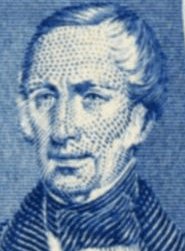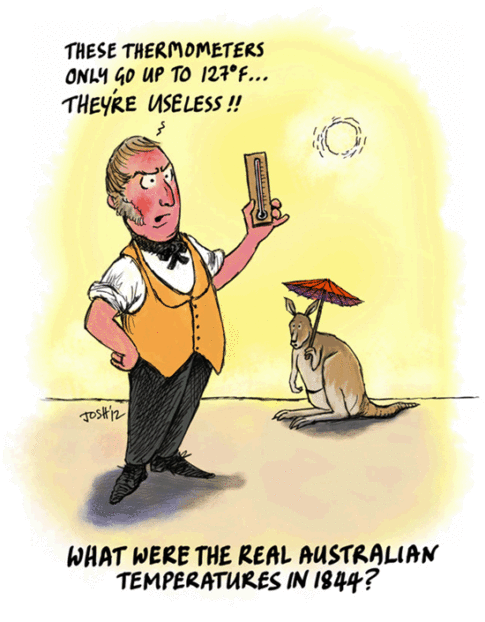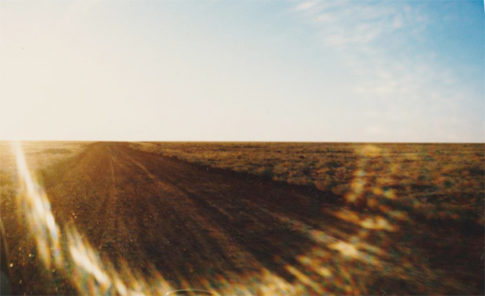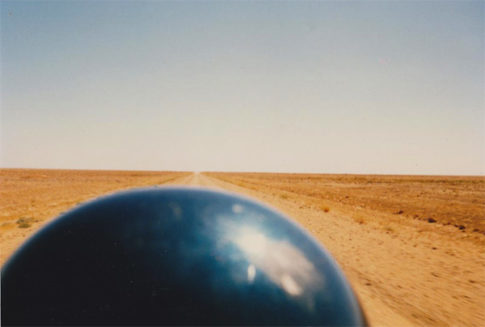Australia’s hottest day? Not 2010, but 1828 at a blistering 53.9 °C
Back before man-made climate change was frying Australia, when CO2 was around 300ppm, the continent savoured an ideal preindustrial climate, right? (This is the kind of climate we are spending $10bn per annum to get back too?)
We are told today’s climate has more records and more extremes than times gone by, but the few records we have from the early 1800’s are eye-popping. Things were not just hotter, but so wildly hot it burst thermometers. The earliest temperature records we have show that Australia was a land of shocking heatwaves and droughts, except for when it was bitterly cold or raging in flood.
In other words, nothing has changed, except possibly things might not be quite so hot now.
Silliggy (Lance Pidgeon) has been researching records from early explorers and from newspapers. What he has uncovered is fascinating. — Jo
——————————————————————————————————-
Charles Sturt (1930 postage stamp) Wikimedia
Lance Pidgeon writes:
“EXTENSIVE FLOOD”, “AWFUL BUSH FIRES”, “PROLONGED DROUGHT“ AND “CHANGES OF CLIMATE“.
These Australian headlines from the 1800?s above describe extremes the early colonists faced. At the time the European explorers who were instructed and equipped to map the country and record the climate were frustrated by the only constant …change.
The heat was extreme – often hotter than 127F!
Like the other explorers Sturt was asked to record everything and in detail:
“You are likewise to note the nature of the climate, as to heat, cold, moisture, winds, rains, &c, and to keep a register of the temperature from Fahrenheit’s thermometer, as observed at two or three periods of each day.”
[From “Letter of Instructions” for his earlier expeditions from “His Excellency Lieutenant General Ralph Darling” Here]
Captain Charles Sturt as he inspects the equipment provided for the 1844-46 expedition into central Australia. Cartoon from Josh of Cartoons by Josh
The equipment provided was not always up to the task. On the equipment provided for one of his later expeditions he remarks:
“The thermometers sent from England, graduated to 127 degrees only, were too low for the temperature into which I went, and consequently useless at times, when the temperature in the shade exceeded that number of degrees” Charles Sturt. [From here].
He was able to acquire and take brewers thermometers. Which were used to measure the “in the sun” temperature and the ‘in the shade” temperatures that were too high for the precision ones. They were also used to estimate height above sea level from the boiling point of water.
Sturt offered his own analysis of some of the typical daily conditions from records in the colony at the time and his own observations.
The periodicity of the weather cycles did not escape his attention.
“The thermometer ranges during the summer months, that is, from September to March, from 36 degrees to 106 degrees of Fahrenheit, but the mean of the temperature during the above period is 70 degrees.”
In degrees C that range equates to a minimum of 2.2 , a max of 41.1 with a mean of 21.1.
This average seems close to the current average but the lower and upper temperatures were both more extreme than they are now!
“The most serious disadvantages under which the colony of New South Wales labours, is in the drought to which it is periodically subject. Its climate may be said to be too dry; in other respects it is one of the most delightful under heaven; and experience of the certainty of the recurrence of the trying seasons to which I allude, should teach men to provide against their effects. Those seasons, during which no rain falls, appear, from the observations of former writers, to occur every ten or twelve years; and it is somewhat singular that no cause has been assigned for such periodical visitations. Whether the state of the interior has anything to do with them, and whether the wet or dry condition of the marshes at all regulate the seasons, is a question upon which I will not venture to give my decisive opinion. But most assuredly, when the interior is dry, the seasons are dry, and VICE VERSA.” From here. Bold mine.
A map of Charles Sturts Route in South Eastern Australia Image: Wikimedia
Later and further out west all this was about to dramatically change. It was the end of the Dalton minimum and large changes in the climate were taking place Before we get to that. From his earlier expeditions:
Buddah Lake near Trangie N.S.W.
“We were sadly disappointed in the appearance of the lake, which the natives call the Buddah. It is a serpentine sheet of fresh water, of rather more than a mile in length, and from three to four hundred yards in breadth. Its depth was four fathoms; but it seemed as if it were now five or six feet below the ordinary level. No stream either runs into it or flows from it; yet it abounds in fish; from which circumstance I should imagine that it originally owed its supply to the river during some extensive inundation.”
“At 2 p.m. the thermometer stood at 129 degrees of Fahrenheit, in the shade; and at 149 degrees in the sun; the difference being exactly 20 degrees.” Bold mine.
For more info about the water levels at Buddah lake click here.
Sturt seems to have been at Buddah lake early to mid Dec 1828 and in case you missed that temperature: that’s 129 degrees or 53.9 °C.
His thermometer gave a temperature in the shade 0.8 degrees °C hotter than the recently attacked Australian record at Cloncurry QLD from the 16th Jan 1889. It is far hotter than the temperature recorded during the strongest solar cycle of last century, 50.7 degrees °C on the 2nd of January 1960 at Oodnadatta Airport S.A.
He was not alone in recording 129 degrees Sir Thomas Mitchell also recorded 129 F during another expedition at the Bogan river. In his words:
“The thermometer in my tent stood at 117°, and when exposed to the wind rose rapidly to 129°, when I feared the thermometer would break as it only reached to 132°.” 27th Dec 1845.
These texts can be found many places on the net like here and make great “adjustment-proof” reading.
Now before we get back to the temperatures from the dramatic imprisonment for months of Sturt years later by a heatwave that lasts for months:
“The thermometer was seldom under 114 degrees at noon, and rose still higher at 2 p.m. We had no dews at night, and consequently the range of the instrument was trifling in the twenty-four hours. Also from Here (Bold mine)
The cycles of droughts and floods
Expedition into Central Australia 1844 – 1846.
(Historical texts available many places on the net) Like… Here
Again right at the start of Sturt’s narrative in chapter one he notes how the Australian climate changes in a cyclic way through various extremes:
“severe and long continued droughts”…”sudden and terrific floods, which subside, as the cause which gave rise to them ceases to operate; the consequence is, that their springs become gradually weaker and weaker..”
Charles Sturt noticed and recorded many details of the effects of annual variations in the climate, longer cyclic and non cyclic changes as well as changes due to location and local climate. His Narratives are as are those of other explorers riddled with insights into what early Australian climate was like.
“The natives look to this periodical overflow of their river, with as much anxiety as did ever or now do the Egyptians, to the overflowing of the Nile.”
“No one could have watched the changes of the country through which he passed, with more attention than did I not only from a natural curiosity, but from an anxious desire to acquit myself to the satisfaction of the Government by which I was employed.”
“Proceeding down the Murray, I reached at length the commencement of the great fossil formation, through which that river flows. This immense bed rose gradually before me as I pushed to the westward, until it gained an elevation of from 2 to 250 feet,”
“When I reached the point at which Mr. Oxley had been checked, I found the Macquarie, not “running bank high,” as he describes it, but almost dry;”
Massive flooding
“Tenbury pointed out a line of rubbish and sticks, such as is left to mark the line of any inundation, and he told us, that, when he was a boy, he recollected the floods having risen so high in the valley as to wash the foot of these hills. He stated, that there had been no previous warning; that the weather was beautifully fine, and that no rain had fallen; and he added that the natives were ignorant whence the water came, but that it came from a long way off. According to Tenbury’s account, the river must have been fully five and twenty feet higher than it usually rises; and judging from his age, this occurrence might have taken place some twenty years before. As we proceed up the Darling, we shall see a clue to this phenomenon.” Bold mine.
Terrific heat
In many places (too numerous to quote) Sturt comments on how effects like reflection from the bright stony surface or wind may have altered the thermometer reading. I went for a little ride to check the area out in 1988.
Back to Sturt’s notes.
“At noon I took a thermometer, graduated to 127 degrees, out of my box, and observed that the mercury was up to 125 degrees. Thinking that it had been unduly influenced, I put it in the fork of a tree close to me, sheltered alike from the wind and the sun. In this position I went to examine it about an hour afterwards, when I found that the mercury had risen to the top of the instrument, and that its further expansion had burst the bulb, a circumstance that I believe no traveller has ever before had to record.” From here.
“The ground was thoroughly heated to the depth of three or four feet, and the tremendous heat that prevailed had parched vegetation and drawn moisture from everything. The mean of the thermometer for the months of December, January, and February, had been 101 degrees, 104 degrees, and 101 degrees respectively in the shade. Under its effects every screw in our boxes had been drawn, and the horn handles of our instruments, as well as our combs, were split into fine laminae. The lead dropped out of our pencils, our signal rockets were entirely spoiled; our hair, as well as the wool on the sheep, ceased to grow, and our nails had become as brittle as glass. The flour lost more than eight per cent of its original weight, and the other provisions in a still greater proportion. The bran in which our bacon had been packed, was perfectly saturated, and weighed almost as heavy as the meat; we were obliged to bury our wax candles; a bottle of citric acid in Mr. Browne’s box became fluid, and escaping, burnt a quantity of his linen; and we found it difficult to write or draw, so rapidly did the fluid dry in our pens and brushes. It was happy for us, therefore, that a cooler season set in, otherwise I do not think that many of us could much longer have survived. But, although it might be said that the intense heat of the summer had passed, there still were intervals of most oppressive weather.”
Bold temps above equate to: Dec. 38.3 °C, Jan 40 °C and Feb 38.3 °C.
Back to Sturt again.
Then it got hotter the following November! With both the >127 F exploding thermometer and the following.
“The heat was greater than that of the previous summer;
the thermometer ranging between 110 degrees and 123 degrees every day;
the wind blowing heavily from N.E. to E.S.E. filled the air with
impalpable red dust, giving the sun the most foreboding and lurid
appearance as we looked upon him. The ground was so heated that our
matches falling on it, ignited; and, having occasion to make a night
signal, I found the whole of our rockets had been rendered useless, as on
being lit they exploded at once without rising from the ground.” From here“I therefore turned towards the ranges, and arriving at the upper water-hole at half-past two, determined to stop until the temperature should cool down in the afternoon before I proceeded along the line of hills to the N.E., for the day had been terrifically hot, and both ourselves and our horses were overpowered with extreme lassitude. At a quarter past 3, p.m. on the 21st of January, the thermometer had risen to 131 degrees in the shade, and to 154 degrees in the direct rays of the sun” Bold mine. From here.
“The night of the 6th”(JUNE)” was the coldest night we experienced at the Depot, when the thermometer descended to 24 degrees.”
That is minus 4.4 C. The coldest recorded nearby according to the BOM has been -2.5 at Tibooburra. So the range of the thermometer back then seems to have been greater.
“We reached our destination at 3 p.m., as we started early, and on looking at the thermometer fixed behind a tree about five feet from the ground, I found the mercury standing at 132 degrees; on removing it into the sun it rose to 157 degrees. Only on one occasion, when Mr. Browne and I were returning from the north, had the heat approached to this; nor did I think that either men or animals could have lived under it.” bold added.
The lack of floods in N.S.W was noticed by the locals at the time and comments were made about it being like this “Since white-man came in country”. See post from Jo Nova here. .
The temperatures recorded by the explorers were for official government and nation building purposes. The explorers possibly had some fear of not being believed or even being accused of exaggeration. This could explain why the early reports of Sturt’s travels in the newspapers of the time carried even higher temperatures.
“It may give His Excellency some idea of the heat to which we were exposed, when I assure you that I found the thermometer which I had lefl with Joseph, and which was fixed in the shade of a large tree, four feet from the ground, stationary 135 ° of Fahrenheit at half-past two p.m., and that in the direct rays of the sun it rose to 157 °. It had, on a former occasion, when Mr, Browne was with me, Stood at 132 ° in the shade, and 153 ° in the sun.”
The Courier (Hobart, Tas.) Saturday 11 October 1845
That is 57.2°C, four feet from the ground and in the shade!
The same accuracy may not be expected from an even earlier report of 135 F from South Australia in 1937 here, here and here. The writers at the time must have thought them believable.
* * *
PayPal: Donate in USD
PayPal: Donate in EUR
PayPal: Donate in GBP




